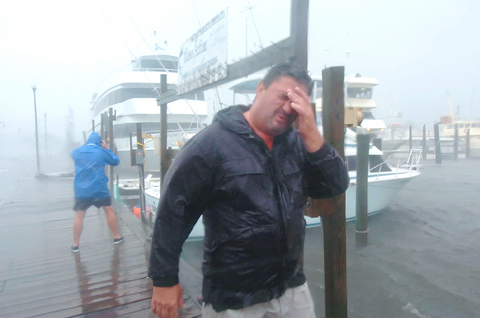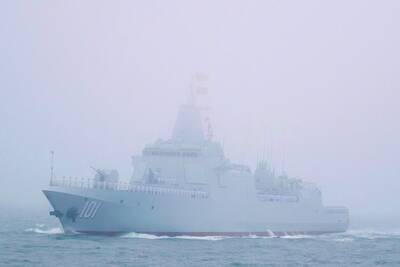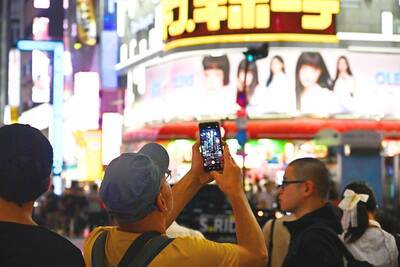Hurricane Katrina already has become the seventh deadliest natural disaster to strike the US, a tragic footnote that comes even as some of the dead are still uncounted.
So far, the official toll across five states is at 710, with New Orleans accounting for most of the dead. Those numbers, while horrific, raised the possibility that earlier fears of fatalities reaching 10,000 or more might not prove true.
If casualties rose that high, it would place the devastation in New Orleans and the surrounding Gulf Coast with such disasters as the Galveston Hurricane of 1900 or the Johnstown Flood of 1889, cataclysmic events that reshaped government policy and captured the nation's sympathy for generations.

PHOTO: AP
"In recent history, this one's bound to be an extraordinary disaster," said Walter Gillis Peacock, director of the Hazard Reduction and Recovery Center at Texas A&M.
That's not only because of the deaths and destruction, but also because of the vast numbers of people displaced, Peacock and other experts said.
"Just the fact that a major American city had to be evacuated, there's no precedent for that -- not just in American history, but world history," said Theodore Steinberg, author of Acts of God: The Unnatural History of Natural Disasters in America, and a history professor at Case Western Reserve University in Cleveland, Ohio.
Hurricane Andrew in 1992, up until now the most expensive hurricane, killed just 26 people, most in southern Florida. It doesn't even rank among the top 10 deadliest natural disasters.
Taking roughly 700 lives each were the Great New England Hurricane of 1938 (720 deaths estimated), the San Francisco Earthquake of 1906 (700 deaths estimated), the Georgia-South Carolina Hurricane of 1881 (700 deaths estimated) and the Tri-State Tornado of 1925, which took an estimated 695 lives in Missouri, Illinois and Indiana.
Only the deadliest five US disasters killed 1,000 or more. These include the Galveston Hurricane of 1900, with some 8,000 deaths; the Great Okeechobee Hurricane that struck Florida in 1928, with more than 2,500 dead; the Johnstown, Pennsylvania, Flood, 1889, estimated 2,200-plus; and two hurricanes in 1893 -- one in Louisiana that killed more than 2,000, and one in South Carolina and Georgia that took somewhere between 1,000 and 2,000 lives, according to Rusty Pfost, a meteorologist with the National Weather Service.
And the toll doesn't even compare to some of the sweeping devastation seen around the world, such as last year's tsunami or the deaths in Central America caused by Hurricane Mitch in 1998. But this year's disaster may lodge itself more firmly in the public mind because of the searing images that came with it of evacuees left for days without food and water, the ineffectiveness of government officials.
"We failed in terms of preparedness and response to this event. We can't really afford to forget," said Havidan Rodriguez, director of the Disaster Research Center at the University of Delaware.

Ten cheetah cubs held in captivity since birth and destined for international wildlife trade markets have been rescued in Somaliland, a breakaway region of Somalia. They were all in stable condition despite all of them having been undernourished and limping due to being tied in captivity for months, said Laurie Marker, founder of the Cheetah Conservation Fund, which is caring for the cubs. One eight-month-old cub was unable to walk after been tied up for six months, while a five-month-old was “very malnourished [a bag of bones], with sores all over her body and full of botfly maggots which are under the

BRUSHED OFF: An ambassador to Australia previously said that Beijing does not see a reason to apologize for its naval exercises and military maneuvers in international areas China set off alarm bells in New Zealand when it dispatched powerful warships on unprecedented missions in the South Pacific without explanation, military documents showed. Beijing has spent years expanding its reach in the southern Pacific Ocean, courting island nations with new hospitals, freshly paved roads and generous offers of climate aid. However, these diplomatic efforts have increasingly been accompanied by more overt displays of military power. Three Chinese warships sailed the Tasman Sea between Australia and New Zealand in February, the first time such a task group had been sighted in those waters. “We have never seen vessels with this capability

A Japanese city would urge all smartphone users to limit screen time to two hours a day outside work or school under a proposed ordinance that includes no penalties. The limit — which would be recommended for all residents in Toyoake City — would not be binding and there would be no penalties incurred for higher usage, the draft ordinance showed. The proposal aims “to prevent excessive use of devices causing physical and mental health issues... including sleep problems,” Mayor Masafumi Koki said yesterday. The draft urges elementary-school students to avoid smartphones after 9pm, and junior-high students and older are advised not

Chinese President Xi Jinping (習近平) attended a grand ceremony in Lhasa yesterday during a rare visit to Tibet, where he urged “ethnic unity and religious harmony” in a region where China is accused of human rights abuses. The vast high-altitude area on the country’s western edge, established as an autonomous region in 1965 — six years after the 14th Dalai Lama fled into exile — was once a hotbed for protest against Chinese Communist Party rule. Rights groups accuse Beijing’s leaders of suppressing Tibetan culture and imposing massive surveillance, although authorities claim their policies have fostered stability and rapid economic development in